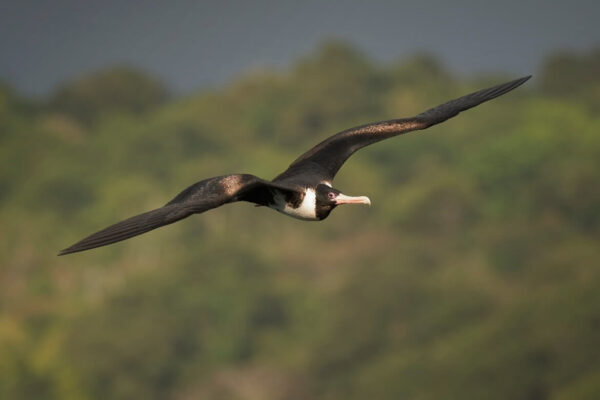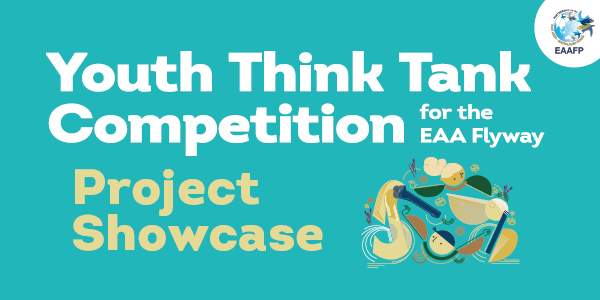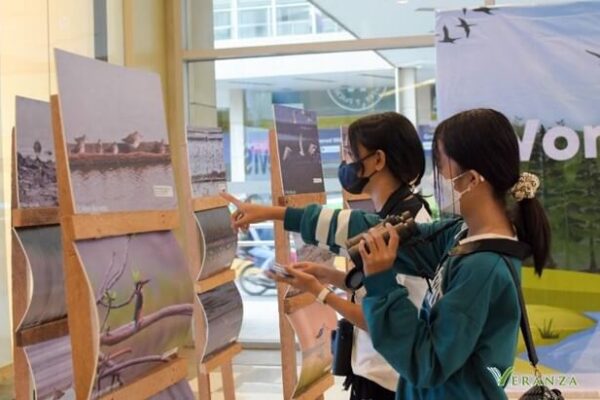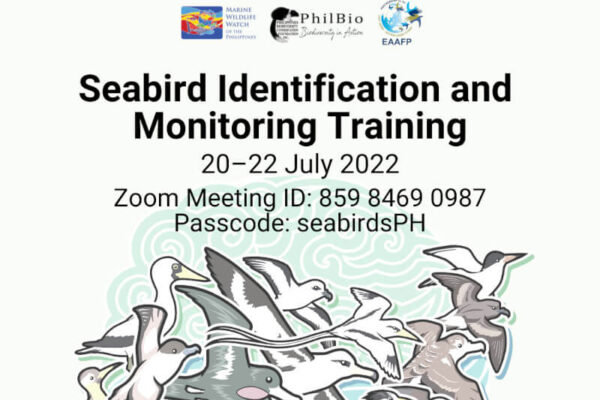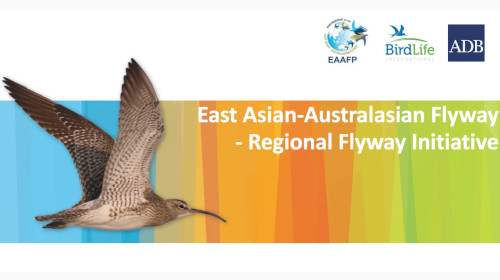-
Conserving Critically Endangered Christmas Island Frigatebird
The Christmas Island Frigatebird (Fregata andrewsi) is a globally threatened migratory seabird; listed as Vulnerable by the International Union for the Conservation of Nature (IUCN). In Australia, the species…
Continue reading -
Introducing the Youth Think Tank Competition Project Teams
The year-long journey for our 5 Youth Think Tank Competition finalist teams has finally come to a close. Although there were challenges, like the COVID pandemic, each team has successfully implemented their project between January and October 2022. Let’s learn more about what each project team has accomplished and would like to share! 1. Grand Final Winner: Team “Dining wetland for birds and people” Dining wetland for birds and people Team ©️ Dining wetland for birds and people “Through interviews with local people we learned about the challenges farmers are facing in balancing the demands of food production and birds in paddy fields. To raise awareness of the issues, gather opinions and ideas and promote the importance of biodiversity, we reached out to the local community and citizens more broadly, especially young people across the country, through online seminars, a photographic competition, and popular science articles. Our motto was: "know more, care more and act more.” - Dining Wetlands for Humans and Birds Team Share the video: link Project location: Nanqiao County, Fengxian district, Shanghai, China Team members: Shuyu Hou, Luyao Chen, Yuhan Li, Xinchen Bu, Yin Zhang Project Summary: Birds, our flying neighbours, are liked and inspire curiosity among citizens. However, they can also cause problems, especially in farmland communities. This project focused on a modern farm site in Nanqiao county, located in the suburbs of the mega-city, Shanghai, where the study site is typical of urban agricultural communities - affection for their flying neighbours but also worry about the damage they cause to crops. Objectives Collect baseline data about biodiversity and community perspectives Build capacity for the Nanqiao community and the broader public about knowledge of birds and their importance Increase awareness and motivate action for bird conservation What had been delivered: Four baseline ecological surveys, using a mixture of camera traps and transects. These surveys recorded 61 bird species and 3 mammals species, filling the data gap and laying the foundation for conservation actions. Two in-person meetings with the local stakeholders to understand the local situation, build a common understanding and agree to collaborate. Received 102 completed questionnaires from the citizens, with 40% from local community. Hosted a "birds in cropland" theme photo contest, attracting 300 votes and reaching a readership of over 1,000 by two articles. Designed and produced stickers, postcards and shopping bags of local bird species of Shanghai, to increase awareness of bird conservation. Published six popular science articles on social media to promote bird knowledge, reaching 2,200 readers. Hosted one online webinar, featuring two keynote speakers from this team and local partners, reaching 800 people. The post-event survey showed that the webinar significantly increased the audience's knowledge of birds PPT Presentation: link Read the report: link Flickr Gallery: Coming Soon! 2. Team “Project Lupad" Project Lupad Team ©️ Project Lupad “The youth is the hope of our nation and the present generation. Let us all remember this quote from Baba Dioum "In the end we will conserve only what we love; we will love only what we understand; and we will understand only what we are taught." Together let us teach and share our love for migratory birds and wetlands so that many people will understand and conserve the things that we love.” - Project LUPAD Team Share the video: Coming soon! Project location: Buayan, General Santos City, the Philippines Team members: Kyle V. Aboy, Melanie P. Genita, Loyd Joredell H. Curit, Roana Mae C. Caguliodo Project Summary: Project Lupad was created because of the need to promote awareness about migratory birds at Barangay Buayan in General Santos City. The overall goal of the project is to narrow the knowledge gap on migratory birds by engaging the youth in communication, education, and public awareness (CEPA) campaigns for migratory birds. The project had three phases: head, hands, and heart. The specific aims of the project are as follows: 1. enhance the youth's knowledge of migratory birds and their ecology through online lectures; 2. develop the youth's skills in making and communicating advocacy or campaign materials for the conservation of migratory birds and their habitats; and 3. raise community awareness about the local issues confronting various wetlands in General Santos City. We started the Head phase by engaging the youth in an online course about migratory birds which ran for one month; this was done via Google Classroom where we posted learning modules and assessed the participant’s learning and via Zoom where we invited speakers to further discuss the topics in the learning modules. The second phase is Hands, where the youth have undergone skills workshops to support migratory bird education and advocacy campaigns. The third phase is Heart, the community engagement caravan where the newly trained youth ambassadors for migratory birds produced their own CEPA materials for the public and the local Buayan community to see. These CEPA materials include infographics, digital arts, PowerPoint presentations, and flash cards which were published physically and digitally and translated into English, Filipino, and Bisaya. 79 participants joined phase 1 of the activities. For phase 3 approximately 200 people visited the exhibit and an additional 150 houses were visited during the house-to-house campaign via a community engagement caravan. PPT Presentation: link Read the report: link Flickr Gallery: Coming soon! 3. Team “Seabirds of Tubbataha” Seabirds of Tubbataha Team ©️ Seabirds of Tubbataha "The Youth Think Tank Competition for Flyway taught us how to create and execute a project from scratch - learned in theory through training courses and practical applications through our project implementation. The Seabirds of Tubbataha project has inspired us to value and better understand seabirds. Along the way, we had the opportunity to collaborate with and learn from individuals who share our interests, including this competition’s organizers, seabird experts, site managers, and our mentor, Micha. It has been a challenging yet enriching experience!" - “Seabirds of Tubbataha” Team Share the video: link Project location: Tubbataha Reefs Natural Park and World Heritage Site, the Philippines Team members: Gerlie T. Gedoria, Anthea Kristha C. Valenzuela, Ira Patricia Alitagtag Project Summary: Tubbataha Reefs Natural Park (TRNP) is the largest no-take marine protected area in the Philippines. It is both an ASEAN Heritage Park and a World Heritage Site. TRNP also became an EAAFP Flyway Network Site in 2015. The two islets of TRNP support over 20,000 seabirds and serve as important nesting and rookery grounds for seven different seabird species, four of which are migratory. Seabirds are highly pelagic, spending most of their time at sea. Their limited interaction with humans due to their isolation may be one reason they are not popular subjects of environmental education activities in the Philippines. Through this project, we designed and implemented a webinar on seabirds and produced a video focusing on the plight of the Black Noddy worcesteri subspecies that was premiered during the webinar. The project aimed to increase awareness amongst Filipinos about seabirds, their importance, and the threats they face, a hundred people at a time. We aimed to highlight the conservation needs of the Black Noddy, which is threatened by loss of nesting habitat, and of Tubbataha generally as a vital seabird breeding ground in Southeast Asia. Through dissemination of the film at the webinar and beyond, we hope to inspire early career and future conservationists to espouse seabird conservation and glean recommendations for improving our management efforts. More than 100 participants joined the various activities. PPT Presentation: link Read the report: link Flickr Gallery: Coming soon! 4. Team “Environmental Education in Dongting Lake” Environmental Education in Dongting Lake Team ©️ Environmental Education in Dongting Lake “On the basis of comprehensive investigation and mastering the natural education resources of Dongting Lake, we used the Project-based Learning (PBL) teaching method to develop a natural education curriculum with the theme of wetlands and birds – I am an ornithologist. The course is divided into two parts: indoor bird class and campus nature game, including five links: wetland discovery, understanding waterfowl, wetland and waterfowl, wading beak competition, migration of migratory birds and nature notes. At the same time, supporting textbooks, teaching aids and course effect evaluation forms are designed. Subsequently, the team organized four environmental education activities in Matang Central Primary School and Mingde Primary School in Yueyang County, with a total of 120 students participating. The children showed great interest in the activity. The interaction between teachers and students in the indoor classroom was continuous, the atmosphere was warm, and the natural games were intense and wonderful. A seed of caring for wetlands and birds has been successfully sown in children's young minds. As children grow up, this seed will take root and sprout, guiding them to approach, love and protect nature and Dongting Lake.” - Edu. in Dongting Lake Team Share the video: link Project location: East Dongting Lake National Reserve, Yueyang City, Hunan Province, China Team members: Xianglong Tang, Wenzhi Xiao, Yu Zhang, Shuangxi Yang Project Summary: Based on a comprehensive survey of Dongting Lake's environmental education resources, we developed and designed the Dongting Lake localization curriculum with wetland cognition, bird cognition and protection as the main contents by using Project-based Learning (PBL) teaching method, a new method of environmental education, and combining the characteristics of wetland and bird-based environmental education resources in Dongting Lake area. We have designed the supporting textbook "Dongting Lake Nature Education Knowledge Manual" and the knowledge folding book "Dongting Home Nature Sharing" to assist the development and implementation of the course. We developed an evaluation system of environmental education curriculum effect, which includes environmental knowledge, environmental attitude and environmental behaviour measurement, and scientifically and reasonably evaluated the effect of activities. We contacted two primary schools in the nature reserve to organize environmental education activities, which included indoor bird classes and outdoor games. During the activity, students are generally interested in the curriculum. No matter whether it is indoor classroom or campus activities, children show great interest, which successfully inspires their love for birds, wetlands and nature, leaving unforgettable memories for children and achieving good teaching results. A total of 120 students joined the activities. PPT Presentation: link Read the report: link Flickr Gallery: Coming soon! 5. Team “Rediscover Kei Island Waterbirds” Rediscover Kei Island Waterbirds Team ©️ Rediscover Kei Island Waterbirds "We are thankful for the opportunity and support from EAAFP throughout the project. We learn to manage our budget wisely because our research site is remote. One of our team members got to learn from the start to do birdwatching and for her it was a very nice experience. Through this project we got to meet people from different backgrounds, and we also learned and gained insight from them to tackle challenges in the field. We hope to do more activities at Kai Islands in the future." - Rediscover Kei Island Team Share the video: link Project location: Kei Islands, Southeast Maluku, Indonesia Team members: Gloria Pratidhwani Manggalagita, Dhia Shofi Salsabilah, Ida Nur Rahmawati Project Summary: The Kei Islands in Indonesia are a vital point for monitoring the East Asia Australia Flyway Network. Unfortunately, bird migration monitoring and observation in the Kei Islands is rarely carried due to its remote location in the waters of the Banda Sea, Indonesia. The last research about bird biodiversity conducted in Kei Island was in 1994. Now Kei Island become new emerging tourist spot in eastern Indonesia. Migratory bird is commonly seen in the Kei Islands and this phenomenon also attracts tourists. This project has conducted waterbirds monitoring in two islands, namely Kei Kecil Island and Mangur Island to update monitoring and lists of Kei Islands birds using line transect methods by walking and by boat or ferry. Upon 22 days of observation (29 March 2022- 19 April 2022), only 20 waterbirds species and 17 land bird species found. Targeted species, Far Eastern Curlew (Numenius madagascariensis) and Great Knot (Calidris tenuirostris). Total of 35 Far Eastern Curlews spotted in Ohoidertawun Beach and Ngurtavur Beach, but no Great Knot was observed. Bird watching has been introduced to residents by doing birdwatching session with children in Mangur and discussion session with total 20 person reached. From fourteen observation sites there are two important habitat that need to be manage sustainably which are Ohoidertawun Beach and Ngurtavur Beach. Both of the sites are favorite tourism spots in Kei Islands, hence the threat of habitat loss and anthropogenic disturbance are higher. Discussion with three tourism actors have been conducted three times and but no code of conduct of eco-friendly & migratory bird-friendly has been drafted yet. PPT Presentation: link Read the report: link Flickr Gallery: Coming soon! For more about the Youth Think Tank Competition for the EAA Flyway click here. The Closing Ceremony was held on 22 October, 2022, click here to learn more.
Continue reading -
Celebration of World Migratory Bird Day 2022 in Philippines – “Learning Event and Exhibit” by Ibaraki Academy
The Ibaraki Academy celebrates World Migratory Bird Day 2022, on 8-9 October 2022. The title of the event is “Learning Event and Exhibit” was held at Veranza Mall, General…
Continue reading -
The Philippines conducts its 1st National Training on Seabird Identification and Monitoring
In the effort to increase our knowledge and capacities in conserving seabirds in the Philippines, the Biodiversity Management Bureau of the Department of…
Continue reading -
Official Launching of the Regional Flyways Initiative Webpage
The EAAFP Secretariat is pleased to announce the release of a webpage built up for the Regional Flyway Initiative (RFI). The page was set up to archive RFI-related documents, articles, media, and events for information sharing. A brief introduction of RFI, key documents (RFI Technical Assistance Report and EAAFP Strategic Plan 2019-2028), a list of meetings and webinars, articles, and publications linked to RFI are also available. Link: https://www.eaaflyway.net/regional-flyway-initiative/ The Regional Flyway Initiative was launched in October 2021 by joint efforts with Asian Development Bank, EAAFP, and BirdLife International at the Ecological Civilization Forum of the 15th Conference of Parties to the Convention on Biological Diversity (CBD COP15). The Regional Flyway Initiative seeks to develop a long-term financing program to protect and restore EAAF wetland ecosystems and the services they provide. RFI aims to mobilize large-scale financing to support the protection, maintenance, and restoration of wetlands in East and Southeast Asia, especially coastal wetlands. The initiative aims to strengthen the conservation and sustainable use of wetlands across the region, which are crucial for the livelihoods of hundreds of millions of people and the migratory waterbirds in Asia and the Pacific. This will be achieved through partnerships among governments, non-government organizations, local communities, regional organizations, development agencies, private sectors, and other stakeholders.
Continue reading

